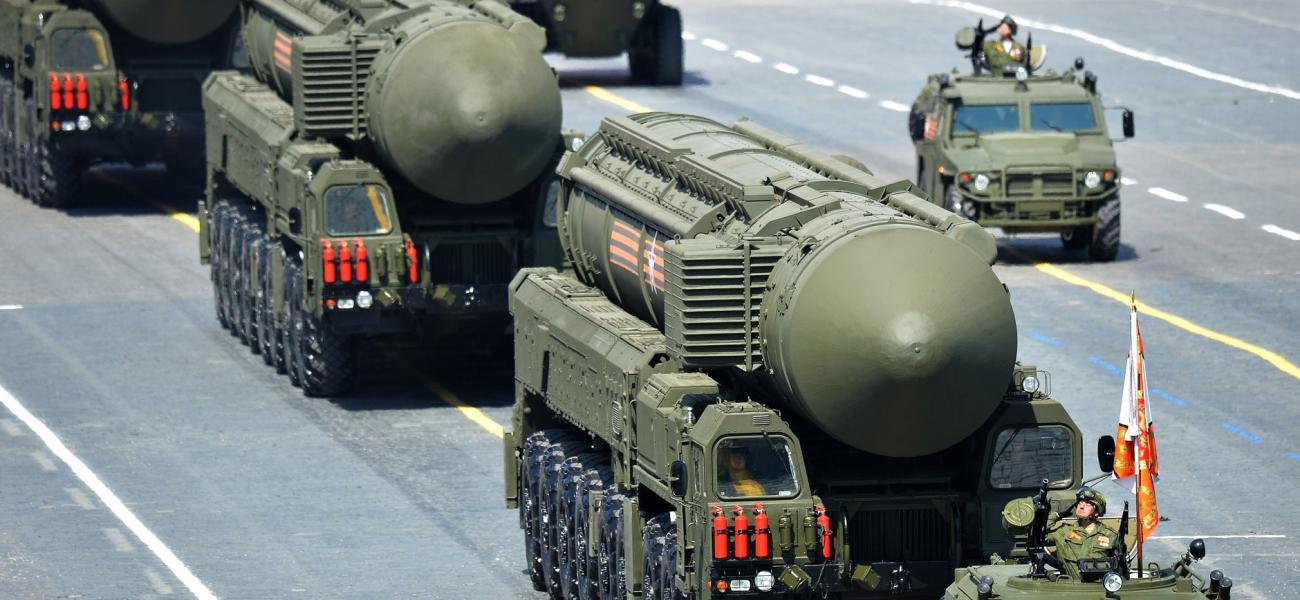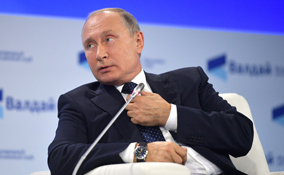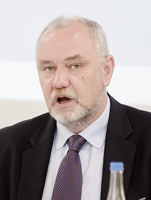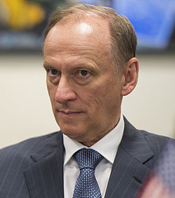
Is 'Escalate to Deescalate' Part of Russia’s Nuclear Toolbox?
"Strategic Deterrence measures are taken continuously by one party, in peaceful and in military times, and not only to prevent acts of force inflicting or able to inflict strategic-level damage on one party, but also for restraining another party within certain boundaries, as well as for deescalating a military conflict.” —Russian Military Encyclopedia
“Deescalation of aggression [means] forcing the enemy to halt military action by a threat to deliver or by actual delivery of strikes of varying intensity with reliance on conventional and (or) nuclear weapons.” 1 —The Priority Tasks of the Development of the Armed Forces of the Russian Federation (2003)
Introduction
The phrase "escalate to deescalate" has worked its way into American security vocabulary and onto the pages of our strategic documents. It describes a supposedly new Russian plan to use limited nuclear strikes in a local/regional conflict, the belief being that such an escalation from conventional2 to nuclear conflict would shock an adversary into suing for peace. In reaction to this alleged doctrine, U.S. policy makers have already ordered the development of new weapon systems and capabilities to ensure Russia's plan cannot work against the United States. Russia's political leaders, however, say they don't have such a plan and that "escalate to deescalate" doesn't exist in their doctrine at all.
Has the United States misunderstood Russian intentions and plans? To answer the question, let's examine the origin of the phrase and what the Russians themselves say about escalating to deescalate. Unfortunately, we cannot read the classified war plans of the Russian government. We will have to rely on unclassified documents, professional articles and public statements, which have their limitations but can nevertheless bring us close to the truth. Spoiler alert: Russia does plan for using nuclear strikes to deescalate (that is, to end) and win conflicts. So does the United States.
What Does the US Mean When Accusing Russia of an ‘Escalate to Deescalate’ Policy?
The phrase “escalate to deescalate” first appeared in American briefings and documents rather than Russian. The wording made its debut in official text in June 2015 when then Deputy Secretary of Defense Robert Work and the vice chairman of the Joint Chiefs of Staff, Adm. James Winnefeld, used it in testimony to the House Committee on Armed Services: “Russian military doctrine includes what some have called an ‘escalate to deescalate’ strategy—a strategy that purportedly seeks to deescalate a conventional conflict through coercive threats, including limited nuclear use. We think that this label is dangerously misleading. Anyone who thinks they can control escalation through the use of nuclear weapons is literally playing with fire. Escalation is escalation, and nuclear use would be the ultimate escalation.”3
By 2018, the phrase had entered official U.S. manuals when speaking about Russian nuclear doctrine. The Defense Department’s 2018 Nuclear Posture Review states: “Moscow threatens and exercises [i.e., rehearses] limited nuclear first use, suggesting a mistaken expectation that coercive nuclear threats or limited first use could paralyze the United States and NATO and thereby end a conflict on terms favorable to Russia. Some in the United States refer to this as Russia’s 'escalate to deescalate' doctrine."4
The idea behind "escalate to deescalate" is not at all new or unique to Russia. As Jay Ross, a U.S. Army Reserve nuclear weapons officer, reminds us in an April 2018 article, the strategy’s conceptual underpinnings follow from Cold War nuclear strategist and Harvard professor Thomas Schelling’s seminal books “The Strategy of Conflict” and “Arms and Influence.” Ross writes that "Russia’s approach to conflict is better described as 'escalation control,' a concept that was a part of the American strategy lexicon until the end of the Cold War." Escalation control is the idea that one side of a conflict can determine the level of violence of a conflict—raising it, for example, in a way that discourages the other side from raising it further. This is precisely the goal of "escalate to deescalate" as Work and Winnefeld understood it.
Stephen Blank, a noted expert on Russian military affairs, asserts that Russia's goal is not only to be able to control escalation at the end of a conflict but to control escalation through all phases of a conflict—understood as “escalation dominance.” According to Blank, "escalate to deescalate"—that is, escalating a conflict to a level of violence that causes the adversary to cease military operations—would be just one example of how Russia might seek to control escalation of a conflict.5
Like other popular phrases, "escalate to deescalate" can mean different things to different people. In its most basic understanding, escalating the violence in a conflict to a level that forces the adversary to capitulate is the very essence of combat. In that sense, "escalate to deescalate" is nothing new and is used by every armed force. But when "escalate to deescalate" is employed by a nuclear state, it can involve the use of weapons so catastrophic that the destruction is qualitatively different from conventional weapons. It is escalation using nuclear weapons that Work and Winnefeld had in mind when they used the phrase "escalate to deescalate." And they were thinking of the specific situation where one side believed that it could launch a limited nuclear strike in such a way as to discourage an adversary from answering with a nuclear strike and thus forcing an end to hostilities.
For the purposes of this paper, we will rely on Work and Winnefeld's definition of “escalate to deescalate”: A Russian strategy that seeks to deescalate (end) a conventional conflict through coercive threats including limited nuclear use.
As both Ross and Blank have noted, the concept of using nuclear weapons to manage the escalation or deescalation of a conflict was a very real strategy used by both Russia and the U.S. during the Cold War. It remains today a part of American nuclear strategy. Department of Defense 2019 Joint Publication 3-72, Nuclear Operations, says: "Employment of nuclear weapons can radically alter or accelerate the course of a campaign. A nuclear weapon could be brought into the campaign as a result of perceived failure in a conventional campaign, potential loss of control or regime, or to escalate the conflict to sue for peace on more favorable terms."6
The Nuclear Operations publication doesn't use the term "escalate to deescalate," but the concept it identifies is exactly the same. So, despite Work's cautionary comment that "anyone who thinks they can control escalation through the use of nuclear weapons is literally playing with fire," it seems American policy makers do think about it.
Russian Denial of ‘Escalate to Deescalate’
Russian policy makers acknowledge that they think about using a nuclear weapon to deescalate a conflict as well, but with a caveat: From the president to the official military doctrine, Moscow’s stated position has been that Russia might use a nuclear weapon first only if the survival of the Russian state were at risk. Russian ambassador to the United States Anatoly Antonov explained this in an April 2019 interview with Russian news service TASS, denying that Russia would use a nuclear weapon first in any other case to "deescalate" a conflict.
Antonov said, "The notorious concept [of] 'escalation for de-escalation' allegedly stipulating the possibility of becoming  the first to use ‘a limited low-yield nuclear strike’ is another flagrant example of the unwillingness to hear us. … I call on all those who doubt to familiarize themselves with Provision 27 of the Russian Military Doctrine.” That provision of the 2014 doctrine says that Russia “shall reserve the right to use nuclear weapons in response to the use of nuclear and other types of weapons of mass destruction against it and/or its allies, as well as in the event of aggression against the Russian Federation with the use of conventional weapons when the very existence of the state is in jeopardy. The decision to use nuclear weapons shall be taken by the President of the Russian Federation." In his interview Antonov added, “so, as Vladimir Putin said: ‘In our concept of using nuclear weapons there is no preventive strike. Our concept is a retaliatory counterstrike.’"
the first to use ‘a limited low-yield nuclear strike’ is another flagrant example of the unwillingness to hear us. … I call on all those who doubt to familiarize themselves with Provision 27 of the Russian Military Doctrine.” That provision of the 2014 doctrine says that Russia “shall reserve the right to use nuclear weapons in response to the use of nuclear and other types of weapons of mass destruction against it and/or its allies, as well as in the event of aggression against the Russian Federation with the use of conventional weapons when the very existence of the state is in jeopardy. The decision to use nuclear weapons shall be taken by the President of the Russian Federation." In his interview Antonov added, “so, as Vladimir Putin said: ‘In our concept of using nuclear weapons there is no preventive strike. Our concept is a retaliatory counterstrike.’"
Putin’s own comments on the topic came during the October 2018 meeting of the Valdai Club, an annual international  gathering of academics, journalists and policymakers: "In our concept of nuclear weapons use there is no preemptive strike… Our concept is a retaliatory-offensive strike [otvetno-vstrechny udar].7 For those who know, it's not necessary to say what that is; for those who don't know, I'll say again: This means we are prepared to, and will use, nuclear weapons only when we are convinced that someone, a potential aggressor, is attacking Russia, our territory."
gathering of academics, journalists and policymakers: "In our concept of nuclear weapons use there is no preemptive strike… Our concept is a retaliatory-offensive strike [otvetno-vstrechny udar].7 For those who know, it's not necessary to say what that is; for those who don't know, I'll say again: This means we are prepared to, and will use, nuclear weapons only when we are convinced that someone, a potential aggressor, is attacking Russia, our territory."
Putin, Antonov and other Russian officials point to their public strategic doctrine documents to support their claims, but doing so is, frankly, pointless: For the Russian military and security community, the word "doctrine" means the policies and strategies within written official documents (almost all of which have “doctrine” in their titles). A reading of the available Russian military and security doctrine documents confirms that the phrase "escalate to deescalate" is not there. Nor is there specific mention of using nuclear weapons to "deescalate" a conflict.8 In Russian parlance, however, doctrine is not intended as a "how we fight" manual. Doctrine is more of a policy guide and a clarification of tasks for the defense departments and organizations. How Russian leaders might employ nuclear weapons would not be part of these doctrinal documents.
Examining the Evidence for ‘Escalate to Deescalate’
Like most countries, Russia classifies its plans for military operations, especially nuclear operations, making it difficult to know whether the concept of "escalate to deescalate" is reflected in Russian plans.9 But we can get insight into their content through professional articles and papers on the subject. These writings greatly support the contention that Russian nuclear thinking includes using limited nuclear strikes to deescalate a conflict, even in cases where the survival of the Russian state is not at risk.
Although "escalate to deescalate" emerged in U.S. discussions around 2015, Russian nuclear experts have been debating the utility of such a strategy since at least the late 1990s. Their discussions have not confined escalation only to nuclear weapons but by any means, including nuclear weapons.
Nikolai Sokov, a former Russian Foreign Ministry officer turned American citizen, was one of the first to expose the  debate over nuclear escalation in a well-documented 1998 report, "Modernization of Strategic Nuclear Weapons in Russia: The Emerging New Posture." Sokov, who had been a Soviet negotiator for START I and II, aggregated for American readers the robust 1990s debate over how to use Russia's nuclear arsenal to guarantee the country’s security at a time when it was in economic and military free fall. "Overall,” he wrote, “the perception of an imminent threat [to Russia] has created a host of (still rather poorly developed) theories analogous to American doctrines of limited nuclear strike, flexible response, limited war, escalation dominance, etc. The purpose is to enable nuclear weapons to achieve a broad variety of missions when less than survival of the country is at stake. To support these missions the strategic force should be capable of a limited exchange, or a ‘demonstration’ strike (similar to what Alexander Haig proposed in the 1980s),10 or of deadlocking the strategic situation in order to improve the chances of success at the substrategic level. Broad missions also require a substantial tactical nuclear potential capable of deterring NATO's conventional forces and dealing with other contingencies (such as conflicts to the south of Russia)."
debate over nuclear escalation in a well-documented 1998 report, "Modernization of Strategic Nuclear Weapons in Russia: The Emerging New Posture." Sokov, who had been a Soviet negotiator for START I and II, aggregated for American readers the robust 1990s debate over how to use Russia's nuclear arsenal to guarantee the country’s security at a time when it was in economic and military free fall. "Overall,” he wrote, “the perception of an imminent threat [to Russia] has created a host of (still rather poorly developed) theories analogous to American doctrines of limited nuclear strike, flexible response, limited war, escalation dominance, etc. The purpose is to enable nuclear weapons to achieve a broad variety of missions when less than survival of the country is at stake. To support these missions the strategic force should be capable of a limited exchange, or a ‘demonstration’ strike (similar to what Alexander Haig proposed in the 1980s),10 or of deadlocking the strategic situation in order to improve the chances of success at the substrategic level. Broad missions also require a substantial tactical nuclear potential capable of deterring NATO's conventional forces and dealing with other contingencies (such as conflicts to the south of Russia)."
The vigorous brainstorming described by Sokov continued after his paper was published. A year later, in 1999, Maj. Gen. Viktor Levshin—a senior missile troops and artillery officer11 and respected expert in the field of nuclear and rocket forces—co-wrote an article recommending a way in which strategic and nonstrategic (tactical) nuclear weapons could be used in concert to deescalate a conflict. Levshin and his coauthors, Col. A.V. Nedelin and Col. M.E. Sosnovskiy, suggested that nonstrategic nuclear weapons—smaller-yield nuclear weapons used on the battlefield—could be used in a phased approach to intimidate an adversary while the threat of using strategic nuclear weapons—longer-range weapons aimed at the adversary's homeland—would deter the opponent from further escalation.12
Levshin's paper, published in the Defense Ministry's elite journal, Military Thought (Voyennaya Mysl), said that "nuclear weapons ought to be regarded not only as a means for bringing about a decisive rout of the adversary but also as a means for deescalating military operations if deterrence proves insufficiently effective and an aggression takes place after all."13
The discussions among Russian military about the possible uses of nuclear weapons were mirrored by similar  discussions among Russia's academic, legislative and civilian defense experts. Writing in 2000, Alexei Arbatov, a Russian scholar and defense expert, described the new role that nuclear weapons had to play, given Russia's poor economic and conventional military condition and the threat that NATO posed. At the time, Arbatov was a State Duma member and deputy chairman of the Duma’s Defense Committee; his views reflected those of the security establishment and arms negotiation community: "Just as NATO employed a nuclear first-use strategic concept during the decades after 1945 (when NATO needed to emphasize its nuclear forces in order to offset its conventional force vulnerabilities), Russia has chosen the same strategy. Since 1993, it has adopted a nuclear first-use strategic concept in order to deemphasize the weaknesses in its conventional military forces."14
discussions among Russia's academic, legislative and civilian defense experts. Writing in 2000, Alexei Arbatov, a Russian scholar and defense expert, described the new role that nuclear weapons had to play, given Russia's poor economic and conventional military condition and the threat that NATO posed. At the time, Arbatov was a State Duma member and deputy chairman of the Duma’s Defense Committee; his views reflected those of the security establishment and arms negotiation community: "Just as NATO employed a nuclear first-use strategic concept during the decades after 1945 (when NATO needed to emphasize its nuclear forces in order to offset its conventional force vulnerabilities), Russia has chosen the same strategy. Since 1993, it has adopted a nuclear first-use strategic concept in order to deemphasize the weaknesses in its conventional military forces."14
In a separate 2008 paper, Arbatov added to his thinking, writing that in certain situations "Russia may decide to selectively initiate the use of nuclear weapons to ‘deescalate an aggression’ or to ‘demonstrate resolve,’ as well as to respond to a conventional attack on its nuclear forces, command, control, communications and intelligence (C3I) forces (including satellites), atomic power plants and other nuclear targets."15
Russian military experts understand that deescalation of a conflict can be achieved by non-nuclear (conventional) means as well as nuclear. Arbatov envisioned a scenario in which Russia would first attempt to deescalate a conflict by relying on conventional weapons to escalate operations. If that failed, then a nuclear strike might be necessary: "Conventional precision weapons," he wrote, “should be capable of inflicting sufficient losses on attacking NATO forces and bases to induce NATO either to stop its aggression, or to escalate it to the level of massive conventional warfare, including a ground offensive. This would then justify Russia’s first use of tactical nuclear weapons."16
For the same reason, some Russian military experts have advocated investing in the development of a better conventional force, capable of deterring an opponent like the U.S. without resorting to nuclear strikes. Colonels V.I. Polegaev and V.V. Alferov wrote in "Military Thought" in 2015 that it was in Russia's national interests to have an effective non-nuclear deterrent force, the importance of which will only grow: "[I]n the 21st century, the risk that Russian armed forces will be drawn into conflicts with 'controllable' consequences that preclude the necessity of transitioning to nuclear conflict will grow. However, the capabilities of Russia to counter these armed threats continue to decrease. It is necessary to take immediate measures to provide security for the state from external threats using non-nuclear forces. Therefore, the national interests of Russia in the military sphere are answered by the establishment of an effective potential for non-nuclear deterrence, the importance and role of which will only increase."17
But those same experts wrote that "at the present time not enough attention is being paid" to the creation of these conventional capabilities.18 They concluded that Russia must, therefore, continue to rely on nuclear forces to provide the necessary escalation to convince an adversary like the U.S. or NATO to end operations. Furthermore, they advocated the earliest possible use of a nuclear retaliatory-offensive strike in the event of a conflict—within minutes of an aggressor's attack. They wrote: “The destruction (removal from action) of cruise missile ships, cruise missile aviation, tactical aviation and the most important elements of the enemy's command and control system would be unacceptable for him because it could bring him to political and military paralysis. Therefore it was absolutely correct when the president of the Academy of Military Sciences [Gen. Makhmut Gareyev] pointed out the necessity to have the ability 'during literally the first minutes of a conflict to launch retaliatory-offensive strikes [otvetno-vstrechnye udary] on the aggressor, with rocket, aviation and long-range naval systems.'"19
Polegaev and Alferov also maintained that the only way to deter a regional or strategic conflict from ever starting is by having a policy that allows Russia a preemptive or preventive nuclear strike. According to them, in Russia's current economic condition, deterrence, like escalation, cannot be accomplished by conventional weapons only: "Strategic deterrence against a potential aggressor state (or coalition of states) to prevent the unleashing of a large-scale or regional war is unlikely using only conventional forces. It is possible only through the threat of preemptive nuclear action. Therefore it follows that to talk about 'strategic non-nuclear deterrence' as a separate group of military measures is incorrect."20
While Russian military writing provides a clear indication that "escalate to deescalate" is an existing concept in Russian nuclear thinking, an examination of Russia's military exercises provides a less clear answer. Since Russia's resumption of large-scale training maneuvers in 1999, Western observers have alleged that Russian forces practiced using tactical nuclear weapons as part of local or regional war scenarios in over half a dozen exercises. But only in the first of these exercises, Zapad 1999, did Russian military leadership confirm the practicing of tactical nuclear strikes. In the subsequent major combined arms exercises, Russian military leaders have remained mute on whether tactical nuclear weapons were simulated, leaving Western analysts to extrapolate from the types of units and weapons exercised.
Western analysts make a good case that Russian forces do practice the use of tactical nuclear weapons in their large-scale combined arms exercises, but it is not clear from the evidence that they practice using those weapons for the narrow purpose of "escalating to deescalate"—namely to end a conflict. Even in the 1999 Zapad exercise, where the simulated use of nuclear forces was confirmed, it is not clear that the simulated strikes were designed to force an end to the conflict. In fact, Marshal Igor Sergeyev, the Russian minister of defense at the time, explained that the strikes were simulated to demonstrate the willingness to resort to nuclear weapons when “all means of resistance have been exhausted."21 According to one journalist, Sergeyev added that “our army was forced to launch nuclear strikes first, which enabled [it] to achieve a breakthrough in the theater situation.” These reasons for using limited nuclear strikes are not aimed at forcing the end of a conflict with a first strike but at preventing a defeat or achieving an operational breakthrough.
Does ‘Escalate to Deescalate’ Include Preemptive or Preventive Strikes?22
Although some military thinkers, like Polegaev and Alferov, have supported preemptive or preventive strikes, and despite some Russian press reports that missile units have practiced preemptive strikes (uprezhdayuschy udar), senior government officials have uniformly maintained that they do not advocate those kinds of nuclear strikes. 
One notable exception may be Nikolai Patrushev, who has been the secretary of Russia’s National Security Council for over a decade. In October 2009, as a new military doctrine was being finalized by the Russian security community, Patrushev made a surprising prediction to an Izvestia newspaper reporter that the forthcoming military doctrine would allow for Russia to launch preemptive nuclear strikes. Patrushev claimed that Russia is changing and therefore its military doctrine must change too. According to Patrushev, the new doctrine would correct for this, changing the conditions under which nuclear weapons might be used in large-scale or local conflicts. He stated: "There are a variety of prospects for using nuclear weapons depending on the situation and intentions of the likely adversary. In situations critical for national security, a preemptive (preventive) nuclear strike against an aggressor is not excluded."23
It turned out though that Patrushev’s prediction was wrong: Preemptive and preventive nuclear strikes were not part of the military doctrine published in 2010 (nor of the latest 2014 version), at least not in the unclassified portion of the document. Did Patrushev accidentally reveal something from the doctrine's classified nuclear annex? Or did his comments reveal an internal debate among security elites, still ongoing five years later when Polegaev and Alferov wrote their article?
In his 1998 article, Sokov observed that Russian policies about using nuclear weapons, either in a first strike or retaliatory strike, could be purposely vague: "Of course, it is possible that vagueness is intentional and should help to contain any, no matter how limited, military clash or provocation. After all, if there exists even a miniscule chance of escalation to the nuclear level, no NATO country would think about challenging Russia; at least this follows from a Schelling-like analysis which is popular in Russia."
Conclusion
In the end, although the phrase "escalate to deescalate" is not used in openly published Russian doctrine, the Russian professional articles above and others make clear that using nuclear weapons to deescalate a conflict is most definitely part of Russia's nuclear toolbox. We are less sure, however, whether Russia's understanding of "escalate to deescalate" includes preemptive or preventive nuclear strikes. Patrushev suggested yes; Putin suggested no. The reader must decide.
The emergence of the phrase "escalate to deescalate" has generated much debate, not only between the U.S. and Russia but also among U.S. and Western military experts. Some U.S. experts object to it because it is not the phrase the Russians themselves use to describe their strategy. Other experts prefer resurrecting the classic Cold War terminology of escalation control. Still others see the phrase as glib and insufficient to describe the unpredictable outcomes a limited nuclear strike could cause.
These are all fair criticisms. Nothing—certainly no three-word phrase—could fully describe the possible effects of a limited nuclear strike. But the phrase serves a good purpose: It brings attention to an option for using nuclear weapons that remains in the toolbox for both Russia and the United States. It has focused military experts, political leaders and the general public on a dangerous problem that remains with us from Cold War days—the risk of a conventional conflict escalating into a nuclear war.
The author wishes to thank Thomas Schaffner for his expert research, which was referenced throughout the paper, and Simon Saradzhyan and Natasha Yefimova-Trilling for their patient counsel.
Footnotes
- “The Priority Tasks of the Development of the Armed Forces of the Russian Federation,” Moscow, Russia: The Defense Ministry of the Russian Federation, 2003, p. 70.
-
"Conventional" throughout the paper refers to non-nuclear resources, forces, weapons, etc.
-
See p. 4 of linked PDF.
-
See p. 30 of linked PDF.
-
See p.13 of linked PDF.
-
See p. V-3 of linked PDF.
-
Translators use both "preemptive" and "preventive" to translate Putin's word "preventivny." In American military terminology "preventive" strikes occur before any threat is imminent and "preemptive" strikes occur on the eve of an attack by an adversary. Putin was saying that neither kind of strike is part of Russian nuclear doctrine. A second Russian term translated as “preemptive” is “uprezhdayuschy.” Another English term used to translate “otvetno-vstrechny udar” is “retaliatory counterstrike,” as in the TASS translation of Antonov’s comments.
-
Among the public doctrinal documents, the July 2017 framework for Russia’s naval policy to 2030 comes the closest to assigning a task of a deescalatory strike. In section V, on strategic requirements and tasks, paragraph 40, point b, the document tasks the Navy in wartime to have "an ability to inflict an unacceptable amount of damage on an enemy with the goal of forcing him to end military actions on terms guaranteed to support Russia's national interests." However, this task does not specify use of nuclear weapons and does not use the words escalate or deescalate.
-
See, for example: “Russia Classifies Information on Preemptive Nuclear Strikes—Military,” Interfax-AVN as translated by BBC Monitoring, Sept. 5, 2014; “Iz novoy voyennoy doktriny RF uberut polozhenie o preventivnom udare” (“Section on Preventive Nuclear Strike to Be Removed From Russian Federation’s New Military Doctrine"), Interfax, Sept. 5, 2014; Samigullina, Aliya and Olga Bolotova, “Pervym ne udaryat” (“Don’t Strike First”), Gazeta.ru, May 2, 2010.
-
Alexander Haig, then secretary of state, was quoted by Walter Pincus and George C. Wilson in a Nov. 6, 1981, Washington Post article, "Nuclear Warning Shot Plan Disputed," as telling the Senate Foreign Relations Committee that "there are contingency plans in the NATO doctrine to fire a nuclear weapon for demonstrative purposes." According to the authors, a demonstration shot is "normally described as being over water, to show alliance resolve to resist at any cost a Soviet invasion."
-
Levshin served as the chief of staff for missile troops and artillery in the Volga Military District and later in Moscow as head of the General Staff Academy's department for military use of missile troops and artillery. Source: Mikhailovsky Military Artillery Academy unofficial Mail.ru social network page.
-
Levshin and his co-authors recommended: "In modern conditions, OTNW [nonstrategic nuclear weapons] may serve as an important deterring factor in possible regional and local wars. A phased, intimidating employment of OTNW [nonstrategic nuclear weapons] in combination with a demonstration of readiness to employ SNW [strategic nuclear weapons] may become the most powerful inducement for an aggressor to scale down military operations."
-
Levshin, V.I., A. V. Nedelin and M. Ye. Sosnovskiy, “O primenenii yadernogo oruzhia dlya deeskalatsii voyennykh deistvy” (“Use of Nuclear Weapons to Deescalate Military Operations”), Voyennaya Mysl, May-June 1999, accessed via the Foreign Broadcast Information Service (FBIS), Document ID: FTS19990602001557.
-
See p.16 of linked PDF.
-
Arbatov, Alexei, “Reducing the Role of Nuclear Weapons,” paper presented to the Conference on Achieving the Vision of a World Free of Nuclear Weapons, Oslo, Feb. 26-27, 2008, pp. 5-6. (Fixing on the term "demonstrate resolve," one might accuse Arbatov of opening the door for a preemptive use of nuclear weapons, contrary to published doctrine and official statements. But, taken together with Arbatov's numerous other writings in which he repeatedly sees Russian nuclear use only in response to aggression, it seems unlikely he intended this to be an exception.)
-
Ibid., p.19.
-
Alferov, V.V. and V.I. Polegaev, "On Non-Nuclear Deterrence, Its Role and Place in the System of Strategic Deterrence," Voyennaya Mysl, July 31, 2015, Vol. 7, p.4.
-
Ibid, p. 10.
-
Ibid, p. 4.
-
Ibid., p. 9.
-
“Na ucheniyakh ‘Zapad-99’ otrabatyvalos uslovnoe primenenie yadernogo oruzhia” (“Conditional Use of Nuclear Weapon Was Rehearsed at Zapad-99 Exercises”), Interfax, July 10, 1999. For additional background see: Golotyuk, Yuri, "Premiera Minoborony na ‘zapadnom teatre’" (“Defense Ministry’s Premiere in the ‘Western Theater’”), Izvestia, June 29, 1999; Kipp, Jacob, “Russia’s Non-strategic Nuclear Weapons,” Military Review, June 2001.
-
See the distinctions between these terms, in the U.S. and Russian contexts, in footnote 7.
-
The Izvestia article is in a Q&A format. Judging from the parenthetical clarification and the formal style of Patrushev’s answers it seems they were submitted in writing.
Kevin Ryan
Brig. Gen. Kevin Ryan (U.S. Army retired) is an associate fellow at Harvard Kennedy School’s Belfer Center for Science and International Affairs and former U.S. defense attaché to Russia.
Suggested Readings
- Blank, Stephen, editor, “The Russian Military in Contemporary Perspective,” Strategic Studies Institute, U.S. Army War College, September 2019. Comprehensive overview of Russia's military today. See especially “Chapter 9: Russian Nuclear Policy” by Dr. Mark Schneider.
- Chernenko, Elena, “Ogranichenny yaderny udar” ("Limited Nuclear Strike"), Kommersant, June 22, 2019. Russia does not envision a limited nuclear strike and such an event cannot remain limited.
- Trenin, Dmitri, "Russian Views of US Nuclear Modernization," Bulletin of the Atomic Scientists, Vol. 75, Issue 1, pp. 14-18, Jan. 2, 2019. What Russians think Americans think.
- Ross, Jay, "Time to Terminate Escalate to Deescalate—It's Escalation Control," War on the Rocks, April 24, 2018. U.S. perspective on the concept of "escalate to deescalate."
- Krepon, Michael, "Escalating to Deescalate," Arms Control Wonk, Feb. 28, 2018. Examination of U.S. claims about Russian nuclear doctrine and risks of escalation control.
- Arbatov, Alexei, “Yadernoye sderzhivanie—garantiya navsegda” ("Nuclear Deterrence Is a Guarantee Forever"), Nezavisimaya Gazeta, July 5, 2017. Description of uses of nuclear weapons to deescalate conflicts including strategic weapons.
- Schneider, Mark, "Escalate to Deescalate," Proceedings, U.S. Naval Institute, February 2017, Vol.143/2/1,368. Recommendations on how to counter a Russian "escalate to deescalate" strategy.
- Alferov, V.V. and V.I. Polegaev, “O neyadernom sderzhivanii, ego roli i meste v sisteme strategicheskogo sderzhivania” ("On Non-Nuclear Deterrence, Its Role and Place in the System of Strategic Deterrence"), Voyennaya Mysl, July 31, 2015, Vol. 7. On the importance of being first to use nuclear weapons.
- Dyakov, A.S., E.V. Myasnikov and T.T. Kadyshev, “Nestrategicheskoye yadernoye oruzhie. Problemy kontrolya i sokraschenia” ("Nonstrategic Nuclear Weapons. Problems of Control and Reduction"), Center for Arms Control, Energy and Environmental Studies, Moscow Physics-Technological Institute, 2004. Russian article on use of nuclear weapons, including to deescalate conflicts.
- Yost, David S., "Russia's Nonstrategic Nuclear Forces," Naval Post Graduate School, International Affairs, Vol. 77, No. 3, 2001, pp. 531-551. U.S. article capturing Russian thinking on use of nonstrategic nuclear weapons.
- Kipp, Jacob W., “Russia’s Nonstrategic Nuclear Weapons,” Military Review, May-June 2001. Insights into Russian planning for nonstrategic nuclear weapons.
- Arbatov, Alexei, "The Transformation of Russian Military Doctrine: Lessons Learned from Kosovo and Chechnya," Marshall Papers, George C. Marshall Center, July 2000. A Russian perspective on the impact of Kosovo on U.S.-Russian security relations and Russian nuclear thinking.
- Levshin, V.I., A. V. Nedelin and M. Ye. Sosnovskiy, “O primenenii yadernogo oruzhia dlya deeskalatsii voyennykh deistvy” (“On the Use of Nuclear Weapons to Deescalate Military Operations”), Voyennaya Mysl, May-June 1999. Russian professional article on using nuclear weapons to deescalate or end a conflict.
- Sokov, Nikolai, "Modernization of Strategic Nuclear Weapons In Russia: The Emerging New Posture," Program on New Approaches to Russian Security Working Paper No. 6, May 1998. In-depth discussion of the transformation of Russian nuclear weapons thinking in late 1990s.
Photos: Main photo by kremlin.ru. Anatoly Antonov by U.S. Mission Geneva/Eric Bridiers. Vladimir Putin by kremlin.ru. Nikolai Sokov by Heinrich-Böll-Stiftung. Alexei Arbatov by Carnegie Endowment for International Peace. Nikolai Patrushev by U.S. Defense Department.

